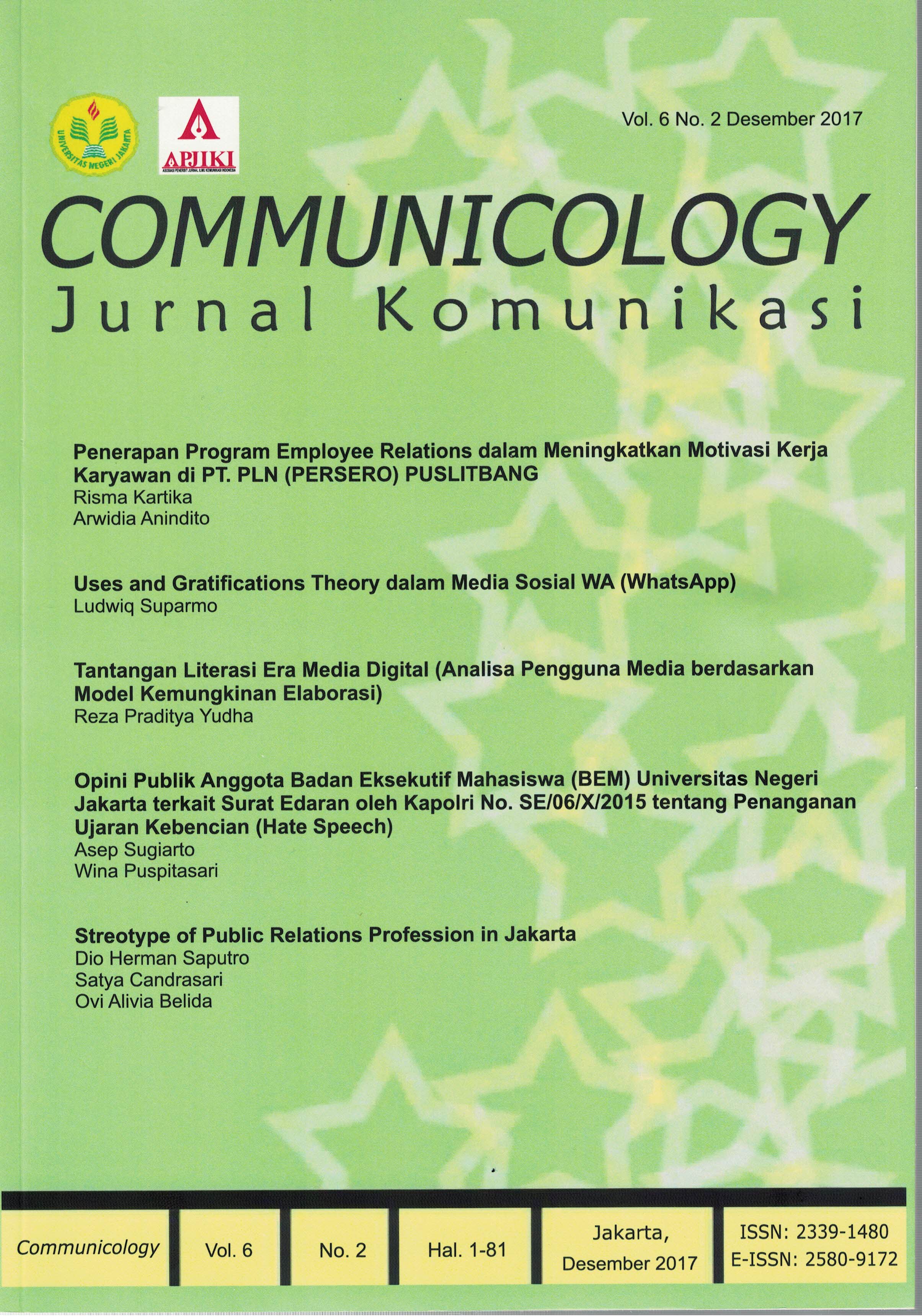STREOTYPE OF PUBLIC RELATIONS PROFESSION IN JAKARTA
DOI:
https://doi.org/10.21009/communicology.062.05Kata Kunci:
Jakarta, Profession, Public Relations, StereotypeAbstrak
Public Relations is known as a female profession, concerned physical, and suitable for women. The purpose of this research is to analyze Public Relations stereotype as a woman profession, concerned with physical, and feminine. This research is examined though face to face in-depth interview method with 10 Public Relations practitioners from variety industry in Jakarta. Findings showed that Public Relations stereotype is not necessarily a pretty woman, physically attractive, and majority men still dabble as Public Relations practitioners in the field of industry. Nevertheless, it cannot be denied that women still dominant in a Public Relations profession. The society's view that the face of PR is a woman show there is a miss perception of PR term itself caused by lack of understanding of PR literacy as management function, not a women profession, equal to actress celebrity's job, and oriented physical. The Negative stereotype about PR profession in Jakarta caused this profession is not as appreciated as a doctor or accountant profession.
Referensi
Ardianto, Elvinaro. (2013). Handbook of Public Relations. Bandung [ID]: Simbiosa Rekatama Media.
Armando, Nina M. (2008). Psikologi Komunikasi. Jakarta [ID]: Universitas Terbuka.
Creedon, Pamela J. (1991). PR and Women's Work: Toward a Feminist Analysis of PR Roles. Dalam, Larissa A. Grunig dan James E. Grunig (eds). Public Relations Research Annual Vol. 3 Hillsdale, New York [US]: Lawrence Erlbaum Associates.
Cutlip, Scott M., Center, Allen dan Broom, Glen M. (2000). Effective Public Relations. Englewood Cliff, New York [US]: Prentice-Hall.
Damayanti, Novita., Harti Yuwarti., & Dio Saputro. (2016). Gender Analysis of the Indonesian Public Relations. [Proceeding] International Conference on Communication Industry and Community. Bali.
Depari, Eduard. (1994). PR dalam dunia usaha: Prospek, peluang dan tantangannya. [Makalah]. Seminar PR dalam Memenangkannya Pertarungan di Dunia Usaha. Jakarta.
Dozier, David M. (1988). Breaking public relations glass ceiling. Public Relations Review. 13(3): 6-12.
Effendy, Onong U. (1986). Human Relations dan PR dalam Management. Bandung [ID]: Alumni.
Fakih, Mansour. (1999). Analisis Gender & Transformasi Sosial. Jakarta [ID]: Pustaka Pelajar Offset.
Griffin, Em., Andrew Ledbetter & Glenn Sparks (2005). A first Look at Communication Theory (9thed) .New York [US]: McGraw Hill Education.
Grunig, J.E dan White, J. (1992). “The Effect of Worldviews on PR Theory and Practice.†Dalam, J.E Grunig (ed). Excellence in Public Relations and Communication Management. Hillsdale, New Jersey [US]: Lawrence Erlbaum.
Hon, Linda C., Grunig, Larissa A. & Dozier, David M. (1992). “Women in Public Relations: Problems and Opportunities.’ Dalam, James E. Grunig (editor). Excellence in Public Relations and Communication Management. Hillsdale, New Jersey [US]: Lawrence Erlbaum.
Indriani, Noorvita. (2009). Pandangan CEO pada Nilai Gender dan Kompetensi Komunikasi SDM Public Relations di Perusahaan IT. Jakarta [ID]: Universitas Mercu Buana.
Kurnia, Novi dan I Gusti Ngurah Putra. (2004). Perempuan Dalam Dunia Public Relations. Jurnal Ilmu Sosial dan Ilmu Politik. 7(3): 393-412
Pambayun, Ellys Lestari. (2009). Perempuan vs Perempuan: Realitas Gender, Tayangan Gosip dan Dunia Maya. Bandung [ID]: Nuansa.
Rachmadi, F. (1994). Public Relations dalam Teori dan Praktek. Jakarta: Gramedia
Regina, Jessica. (2013). Persepsi Mahasiswa Program Studi Public Relations di Jakarta dan Sekitarnya terhadap Mayoritas Perempuan dalam Industri Public Relations. Jakarta [ID]: Universitas Pelita Harapan.
Ridjal, Fauzi dan Agus Fahri Husein. (1993). Dinamika Gerakan Perempuan di Indonesia. Yogyakarta [ID]: PT. Tiara Wacana Yogya.
Simorangkir, Deborah N. (2010a). Gender theories on leadership: An overview of the glass ceiling theory and the role congruity theory. Communique. 6(1): 393-412
____________________. (2010b). The feminization of public relations in Indonesia: Role expectations and prejudices. International Journal of Arts and Sciences, 3(15): 71-89.
Soemirat, Soleh dan Elvinaro Ardianto. (2008). Dasar-Dasar Public Relations. Bandung [ID]: Remaja Rosdakarya.
Sudarta, Wayan. (2003). Peranan wanita dalam pembangunan gender. Jurnal Ilmu Sosial dan Ekonomi Pertanian. 3(1): 250-268
Tannen, Deborah. (1990). You Just Don’t Understand. New York [US]: Ballantine.
Watson, Ton & Yudawarti, Arum Gregoria. (2014). Asian Perspective on the Development of Public Relations: Other Voice: Basintoke: Palgrave Macmilan
Wood, Julia. (2005). Gendered Lives: Communication, Gender, and Culture (6th ed). Belmont, California [US]: Wadsworth.
________________. (2009). Gendered Lives. Boston [US]: Cengage.
Online
Fauzi, Yulianna, “Jumlah Wirausahawan RI Bertambah 4 Juta Orang Dalam 10 Tahun†CNNIndonesia.com https://www.cnnindonesia.com/ekonomi/20160819114219-78-152414/jumlah wirausahawan-ri-bertambah-4-juta-orang-dalam-10-tahun/ accessed December 13, 2017
Unduhan
Diterbitkan
Cara Mengutip
Terbitan
Bagian
Lisensi
Authors who publish with this Journal agree to the following terms:
- Author retain copyright and grant the journal right of first publication with the work simultaneously licensed under a creative commons attribution licensethat allow others to share the work within an acknowledgement of the work’s authorship and initial publication of this journal.
- Authors are able to enter into separate, additional contractual arrangementfor the non-exclusive distribution of the journal’s published version of the work (e.g. acknowledgement of its initial publication in this journal).
- Authors are permitted and encouraged to post their work online(e.g. in institutional repositories or on their websites) prior to and during the submission process, as it can lead to productive exchanges, as well as earlier and greater citation of published works.
Users/public use of this website will be licensed to CC BY





